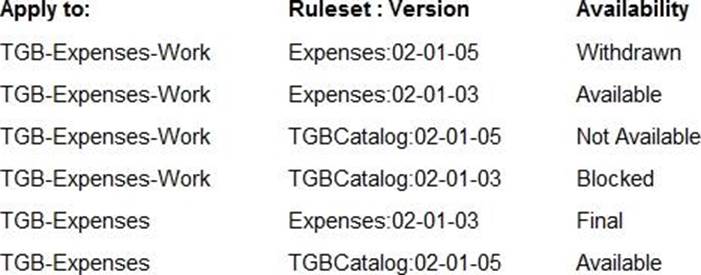Pegasystems PEGAPCSSA85V1 Pega Certified Senior System Architect (PCSSA) 85V1 Online Training
Pegasystems PEGAPCSSA85V1 Online Training
The questions for PEGAPCSSA85V1 were last updated at Nov 19,2024.
- Exam Code: PEGAPCSSA85V1
- Exam Name: Pega Certified Senior System Architect (PCSSA) 85V1
- Certification Provider: Pegasystems
- Latest update: Nov 19,2024
A service receives a request to assign an office to a new employee.
The service rejects the username and/or password provided
What type of fault condition do you configure to return an appropriate response?
- A . Security error
- B . Queue when
- C . Service error
- D . Mapping error
You need to localize correspondence into a language that is unavailable in the Pega language pack.
Which option satisfies the requirement?
- A . Run the Localization wizard and add translations to Translation.html.
- B . Create the Translation rule manually and include the rule in the application ruleset.
- C . Leverage translation services SOAP calls and enable records for translation.
- D . Configure a field value record that contains the correspondence text.
The primary purpose of a production ruleset is to allow rules to be.
- A . reused in multiple production environments
- B . tested in a production environment
- C . updated in a production environment
- D . migrated to a production environment
C
Explanation:
Reference: https://collaborate.pega.com/QUESTION/production-and-application-rulesets
What two actions must you perform to create a class join in a report definition? (Choose two.)
- A . Create a prefix for the joined class.
- B . Add an association rule to match key values.
- C . Add a parameter for each property in the class you want to join.
- D . Select the type of match for key values.
A,B
Explanation:
Reference: http://myknowpega.com/2017/12/25/report-definition-class-join-declare-index-join-associations-sub-reports/
You are analyzing application performance and notice one or more data transforms exceeding preferred performance parameters.
Which of the following performance tools do you use to help troubleshoot the issue?
- A . Pega RULES Log Analyzer
- B . Database Trace
- C . Performance Profiler
- D . Performance Analyzer
C
Explanation:
Reference: https://archive.org/stream/SeniorSystemArchitectGuide/Senior%20System%20Architect%
20Guide_djvu.txt
What are three valid ways to exchange data through a Pega Web Mashup? (Choose three.)
- A . Use an SQL call to exchange data between the mashup and hosting web page.
- B . Use the data-pega-event-onpagedata attribute to configure the default value for the gadget.
- C . Use a queue processor to pass updated attributes to the gadget on the hosting web page.
- D . Use an action object configured as a script to perform additional actions on a web mashup gadget.
- E . Use the Javascript function doAction() to set or read data values through the hosting web page.
B,D,E
Explanation:
Reference: https://collaborate.pega.com/QUESTION/pega-mashup-data-passing
A class group is used to.
- A . identify a layer of the Enterprise Class Structure
- B . combine related properties by usage
- C . assign work to a specific group of users
- D . store data from different child classes in a single table
D
Explanation:
Reference: https://collaborate.pega.com/QUESTION/what-class-groupdoesnt-belongs-classgroup-and-belongs-classgroup
What are two consequences of exposing columns for reporting? (Choose two.)
- A . Backward chaining declare expressions cannot use exposed properties.
- B . Record inserts and updates require more processing time.
- C . Tables require additional space due to additional columns.
- D . The database may not comply with normalization standards.
An application has the following application rulesets:
Expenses:02-01
TGB:02-01
TGBCatalog:02-01
A rule with an Apply to : class of TGB-Expenses-Work-Reimbursement references a rule named PopulateLineltems .
The six instances of PopulateLineltems in the rules cache are shown in the following table.

Which rule is chosen by Rule Resolution?
- A . TGB-Expenses.PopulateLineltems (TGBCatalog:02-01-05)
- B . TGB-Expenses-Work.PopulateLineltems (TGBCatalog:02-01-05)
- C . TGB-Expenses-Work.PopulateLineltems (Expenses:02-01-05)
- D . TGB-Expenses-Work.PopulateLineltems (TGBCatalog:02-01-03)
- E . TGB-Expenses-Work.PopulateLineltems (Expenses:02-01-03)
- F . TGB-Expenses.PopulateLineltems (Expenses:02-01-03)
You are preparing to create a new major version of an application ruleset in which there are multiple minor and patch versions.
How do you create the new ruleset version?
- A . Use the Ruleset Maintenance wizard to merge the existing rules in the relevant ruleset versions to the new version.
- B . Use the Ruleset Maintenance wizard to skim the relevant ruleset versions to copy the highest version of existing rules to the new ruleset version.
- C . Create a new application ruleset using the appropriate version number, then copy the highest version of existing rules into the new ruleset version.
- D . Use the Application Structure landing page to lock and roll the existing ruleset versions to the new version.
B
Explanation:
Reference: https://community.pega.com/knowledgebase/articles/how-skim-compress-merge-copy-and-delete-rulesets-ruleset-maintenance-wizard
Latest PEGAPCSSA85V1 Dumps Valid Version with 200 Q&As
Latest And Valid Q&A | Instant Download | Once Fail, Full Refund

